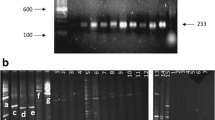Abstract.
Objective: To confirm the sensitivity of the polymerase chain reaction (PCR) technique (versus blood cultures) and to gain a better understanding of the incidence of true- and false-positive results when using this technique. Design: Observational study. Setting: Fourteen-bed, level 3 intensive care unit. Patients: Hundred twenty-six critically ill adult patients. Hundred ninety-seven blood culture and PCR samples taken as clinically indicated for suspected sepsis, according to routine ICU protocol. Measurements and results: The PCR product (16SrDNA: 341F–1195R) was sequenced and compared with a database of known species (Genebank) to identify the bacterial nucleic acid. The PCR or blood culture result was classified as a true-positive if there was other microbiological or clinical supporting evidence.
Similar content being viewed by others
Author information
Authors and Affiliations
Additional information
Final revision received: 13 March 2001
Electronic Publication
Rights and permissions
About this article
Cite this article
Sleigh, J., Cursons, R. & La Pine, M. Detection of bacteraemia in critically ill patients using 16S rDNA polymerase chain reaction and DNA sequencing. Intensive Care Med 27, 1269–1273 (2001). https://doi.org/10.1007/s001340100981
Received:
Accepted:
Published:
Issue Date:
DOI: https://doi.org/10.1007/s001340100981




